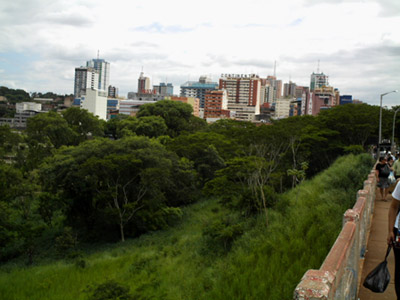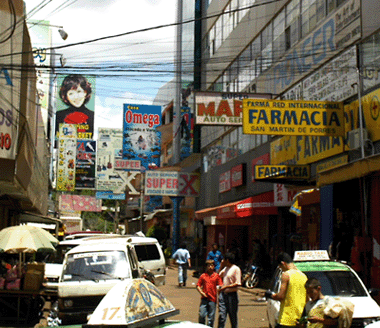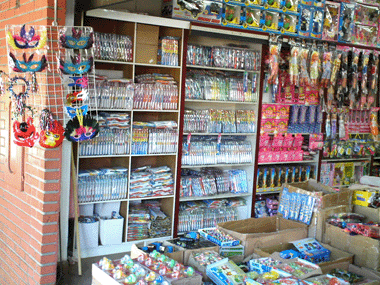Source: EXTRA!
 When we arrived in Ciudad del Este, we were petrified. After all, we were in the Paraguayan city known in the American press as a “Jungle Hub for World’s Outlaws” (L.A. Times, 8/24/98), and a “hotbed” “teeming with Islamic extremists and their sympathizers” (New York Times, 12/15/02).
When we arrived in Ciudad del Este, we were petrified. After all, we were in the Paraguayan city known in the American press as a “Jungle Hub for World’s Outlaws” (L.A. Times, 8/24/98), and a “hotbed” “teeming with Islamic extremists and their sympathizers” (New York Times, 12/15/02).
The U.S. media’s portrayal of this city, the center of a zone on the frontiers of Argentina and Brazil known as the Tri-Border Area, left us expecting to see cars bombs exploding, terrorists training and American flags burning. We soon realized that picture painted by U.S. media was inaccurate. In the Cold War, Washington and the media used the word “communism” to rally public opinion against political opponents. Now, in the post- September 11 world, there is a new verbal weapon-“terrorism.” Despite a lack of evidence, Washington and the media are asserting links to terrorism in the Tri-Border Area to advance their agenda in a region that is increasingly shifting to the left.
The rumors date back to two anti-Semitic bombings in Buenos Aires in the 1990s-a 1992 attack on the Israeli embassy and a 1994 bombing of a Jewish community center. Ciudad del Este, with its large Arab population, made an easy scape-goat. Though the attacks were never proven to be connected to Ciudad del Este, journalists since the bombings have had Washing-ton’s go-ahead to promote the unverified hypothesis that Hez-bollah (or any other Middle Eastern group designated as a terrorist organization) is finding refuge in the Tri-Border Area.
Ciudad del Este has been described (New York Times, 8/24/98) as “a capital of institutionalized smuggling that today flows back and forth to other Latin nations, Europe, the United States, Asia and the Middle East.” That’s not necessarily inaccurate, as far as it goes-there is a lot of smuggling and organized crime in the Tri-Border Area-but U.S. coverage of Ciudad del Este is marked by a combination of sensationalism and xenophobia.

Mixing orientalism with fears of illegal immigrants, the L.A. Times (8/24/98) called the city a seething “Latin American casbah” with “tens of thousands of small-time smugglers, as brazen and numerous as illegal crossers at the U.S. border.” In “alleys dense with tables of pornographic videos,” New Yorker writer Jeffrey Goldberg (10/21/02) found an “alarming enclave of lawlessness,” a “filthy and disgusting” place where “everything is illegal.” The New York Times (8/24/98) described the “jungle hamlet” as a “slow-motion riot” of “urban mayhem,” with “predatory street kids” and a “trash-strewn downtown.”
Of late, another theme has been creeping into reports on Ciudad del Este: the spectre of terrorism. In the words of the New York Times (8/24/98), the area is not just a “magnet for organized crime” but “a danger to the entire continent.” The Tri-Border, the paper reported, is “a free zone for significant criminal activity, including people who are organized to commit acts of terrorism.” The L.A. Times (8/24/98) put it simply: It is “a prototypical laboratory for developing a base for bad guys.”
Missing evidence
What’s missing from the pieces painting the Tri-Border Area as a hotbed of terrorism is evidence. Paraguayan officials protested accusations that Ciudad del Este was funding Hezbollah. “There’s no proof, only suspicions,” Washington Times journalist Mike Caesar (10/26/01) quoted officials as saying.
Nearly every article reporting on Islamic terrorism in the Tri-Border Area is honeycombed with qualifying language indicating that, despite a lack of clear evidence, U.S. officials say that there are probably links to terrorist organizations in the Tri-Border Area. The New Yorker‘s Goldberg perhaps went the farthest in his claims that the Tri-Border region hosts a hard core of terrorists, a community under the influence of extreme Islamic beliefs; Hezbollah runs weekend training camps on farms cut out of the rain forest of the Triple Frontier. In at least one of these camps, in the remote jungle terrain near Foz do Iguaçu, young adults get weapons training and children are indoctrinated in Hezbollah ideology-a mixture of anti-American and anti-Jewish views inspired by Ayatollah Khomeini.
 Goldberg’s certainty about these claims-for which he supplied scant evidence-is reminiscent of a later article he wrote as the U.S. government was gearing up for a war in Iraq (New Yorker, 2/2/03), confidently linking Al-Qaeda and Saddam Hussein. The article was gratefully cited by the Bush administration to further their argument for war. Veteran muckraker Alexander Cockburn (CounterPunch, 3/28/03), pointing out various inaccuracies in that article, described it as “a servile rendition of Donald Rumsfeld’s theory of intelligence: ‘Build a hypothesis, and then see if the data supported the hypothesis, rather than the reverse.'”
Goldberg’s certainty about these claims-for which he supplied scant evidence-is reminiscent of a later article he wrote as the U.S. government was gearing up for a war in Iraq (New Yorker, 2/2/03), confidently linking Al-Qaeda and Saddam Hussein. The article was gratefully cited by the Bush administration to further their argument for war. Veteran muckraker Alexander Cockburn (CounterPunch, 3/28/03), pointing out various inaccuracies in that article, described it as “a servile rendition of Donald Rumsfeld’s theory of intelligence: ‘Build a hypothesis, and then see if the data supported the hypothesis, rather than the reverse.'”
Though the press reports might not have had much evidence, they ensured that further unverified reports of terrorism in the Tri-Border Area could point to those news accounts as proof of a sort, however hollow. The Federal Research Division of the Library of Congress released an official report (7/03) titled Terrorist and Organized Crime Groups in the Tri-Border Area (TBA) of South America. Using thinly sourced media accounts to gloss over the lack of proof linking the early ’90s bombings to the Tri-Border Area, the report glibly summarized the next 10 years: “Since the1994 attack, Islamic terrorists in the TBA have largely confined their activities to criminal fundraising and other activities in support of their terrorist organizations, including plotting terrorist actions to be carried out in other countries.”
Using media reports (among them the New Yorker, New York Times and L.A. Times articles cited above) as its conclusive evidence of terrorist groups in the region, the report concluded with a section titled “The TBA as a Haven and Base for Islamic Terrorist Groups.” The bulleted finale stated that “various Islamic terrorist groups, including the Egyptian Al-Jihad (Islamic Jihad) and Al-Gama’a al-Islamiyya (Islamic Group), Hamas, Hezbollah and Al-Qaeda, probably have a presence in the TBA; Hezbollah and Al-Qaeda are probably cooperating in the region, but definitive proof of this collaboration, in the form of a specific document, did not surface in this review.” Indeed, proof that the Shiite Hezbollah was working with the ferociously anti-Shiite Al-Qaeda would be remarkable news.
A new generation of rumors
The Library of Congress report’s release prompted a flurry of new coverage, citing the report as solid evidence of terrorism links in the TBA. The most confident officials declared their conviction that Paraguay’s “illicit activities help finance global terror”: “That is fact, not speculation,” insisted U.S. Southern Command chief Gen. James Hill, without offering any substantiation (Miami Herald, 8/15/03). In the same report, an anonymous Bush administration official was more cautious. “There’s no solid evidence that Al-Qaeda is still present in the region, but ‘we want to do the work of prevention and reduce the flows of money to Hezbollah and Hamas. . . . As terrorists flee the hot spots in the world, we don’t want them to see places like the Tri-Border Area as potential safe havens.'”
 The master of hypothesis verification himself, Donald Rumsfeld, took another approach: ignore the topic altogether. When Rumsfeld visited Asunción in August 2005, he talked about using the Paraguayan military to save bordering Bolivia from the leftist influence of Venezuela, but never mentioned terrorism in the Tri-Border Area. At the time, the Washington Post (8/17/05) reported that “Defense officials said [the TBA] might also harbor groups that finance international terrorism. One Defense official . . . said Hezbollah and Hamas, radical Islamic groups in the Middle East, ‘get a lot of funding’ from the Tri-Border Area.”
The master of hypothesis verification himself, Donald Rumsfeld, took another approach: ignore the topic altogether. When Rumsfeld visited Asunción in August 2005, he talked about using the Paraguayan military to save bordering Bolivia from the leftist influence of Venezuela, but never mentioned terrorism in the Tri-Border Area. At the time, the Washington Post (8/17/05) reported that “Defense officials said [the TBA] might also harbor groups that finance international terrorism. One Defense official . . . said Hezbollah and Hamas, radical Islamic groups in the Middle East, ‘get a lot of funding’ from the Tri-Border Area.”
The issue received steady coverage in 2006. In a June 3, 2006 Associated Press report, Western intelligence officials, speaking anonymously, claimed that if Iran were cornered by the United States, it could use a Hezbollah network based in the TBA to direct terrorist attacks. Again, no evidence was offered, and the Paraguayan government protested the unverified report. On August 3, 2006, Daniel Glaser, deputy assistant treasury secretary for terrorist financing and financial crimes, practiced his verbal gymnastics when talking about “a broad series of new measures aimed at uncovering money-laundering rings that [U.S. officials] believe are funding Hezbollah and other radical groups.” “I am highly confident that’s the case,” Glaser said (Washington Post, 8/2/06). “We believe there is evidence.”
By the end of the year, the U.S. government was ready to take action in an environment saturated with media coverage, if light on evidence. On December 6, 2006, “The U.S. Department of the Treasury . . . designated nine individuals and two entities [in the Tri-Border Area] that have provided financial and logistical support to the Hezbollah terrorist organization” (paraguay.usembassy.gov, 12/6/06). These claims were rejected by Argentina, Brazil and Paraguay. As of August 7, 2007, an article describing the designation was still the top article of the “Latest Headlines from the Americas” section of the U.S. embassy site. The article, titled “Hezbollah Fundraising Network in the Triple Frontier” and dated December 6, 2006, appeared on the front page of the site without a date, misleading readers to believe that it was a current article. Next on the list of news stories was an article dated July 10, 2007.
Seeing for ourselves
To see what was really happening in Ciudad del Este today, we set out into the sunny heat of the city to hear what Paraguayans had to say. The press attaché for the governor of Alto Paraná, the state where the city is located, was shocked to see us: In spite of all the media coverage this city had received in the international media, we were the first two foreign journalists to speak with him. He denied any terrorist activity in the area.

Others were similarly dismissive about claims about terrorist groups. Local vendors and farmers calmly described the mafia activities, drug trafficking and arms smuggling going on in the area, but were quick to point out that there were no links with foreign terrorist groups. A Syrian businessman we spoke with ridiculed the claims, saying Middle Easterners in the area left their home countries to escape violence and war. In a country that ran rampant with rumors, no one seemed to believe the claims of terrorist links for a second.
There are a number of plausible reasons the region has been portrayed as a terrorist stronghold. One is that the current Paraguayan government is one of the Bush administration’s last allies in a region that is increasingly shifting to the left. It is strategically located in the heart of South America, between the politically and economically more powerful countries of Argentina, Brazil and Bolivia. An alliance with the Paraguayan military, justified by an internal threat, can only help expand the Pentagon’s reach in the area.
The Mideastern community in Ciudad del Este makes it potentially easier for Washington to claim a threat of terrorism if the need for a military intervention arises. The area is also rich in natural resources: Bolivia’s vast natural gas reserves are right next door, and the largest fresh water aquifer is under Paraguay’s soil.
Misinformation to militarization
The media misinformation campaign transformed into a military campaign when hundreds of U.S. troops arrived in Paraguay in July 2005. After Washington threatened to cut off millions in aid to Paraguay if its Senate refused the military’s entry, the legislature voted to allow U.S. troops to train Paraguayan military. When the U.S. troops arrived in the country, U.S. funding for counter-terrorism to Paraguay soon doubled, and repression against rural farmer movements subsequently increased.
The media portrayal of Paraguay has facilitated the repression of some of the most powerful protest movements in the country. Small farmers in rural Paraguay are being forced off their land-and in some cases tortured and killed-to make way for the booming soy industry (Upside Down World, 7/17/06). Analysts in Paraguay believe the increased violence against farmers is linked to the presence of U.S. military.
“The U.S. military is advising the Paraguayan police and military about how to deal with these farmer groups,” Orlando Castillo of Service Peace and Justice, a Latin American human rights organization, explained: They are teaching theory as well as technical skills to Paraguayan police and military. These new forms of combat have been used internally. . . . U.S. troops form part of a security plan to repress the social movement in Paraguay. A lot of repression has happened in the name of security and against “terrorism.”
University of Brasília historian Luiz Moniz Bandeira told the Washington Times (10/25/05), “I wouldn’t dismiss the hypothesis that U.S. agents plant stories in the media about Arab terrorists in the Triple Frontier to provoke terrorism and justify their military presence.”
The U.S. Embassy in Asunción denied that the U.S. military is linked to the increased repression against farmers. In December 2006, the Paraguayan Senate voted against renewing the legislation granting the U.S. troops freedom to operate in the country.
Upon leaving Ciudad del Este, we saw children playing baseball in a park, couples walking hand in hand, people fishing in a nearby river and Brazilians on vacation snapping photos. It looked like any other sleepy Latin American city on a Sunday. Given the history of U.S. intervention in the region, we have no reason to trust what is being said in most foreign media about this city. For the last hundred years, the U.S. has been accusing Latin Americans of lawlessness and terrorism. It is easy to make those accusations about places that most North Americans are unlikely to go. Our job, as conscientious news readers, is to ask for evidence and be skeptical of the hype.
April Howard is a journalist and teacher. Benjamin Dangl is the author of The Price of Fire: Resource Wars and Social Movements in Bolivia (AK Press, 2007). He is the editor of TowardFreedom.com, a progressive perspective on world events. April and Ben are both editors at UpsideDownWorld.org a website on activism and politics in Latin America.
All photos copyright April Howard and Benjamin Dangl.
This article was originally printed in September/October 2007 issue of EXTRA! the Magazine of Fairness and Accurary In Reporting, The Media Watch Group. This work is licensed under a Creative Commons License.
